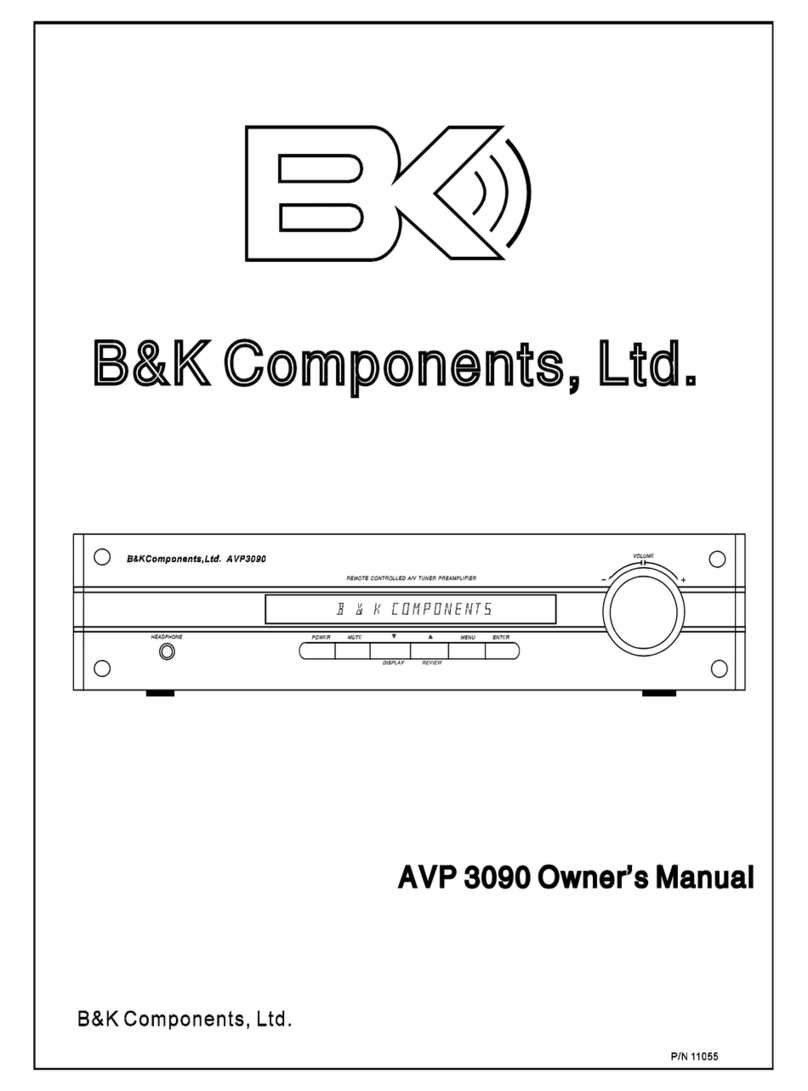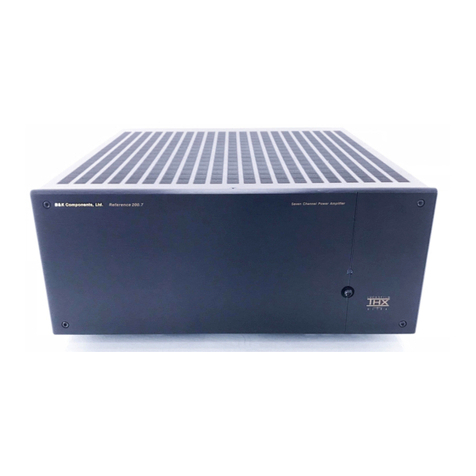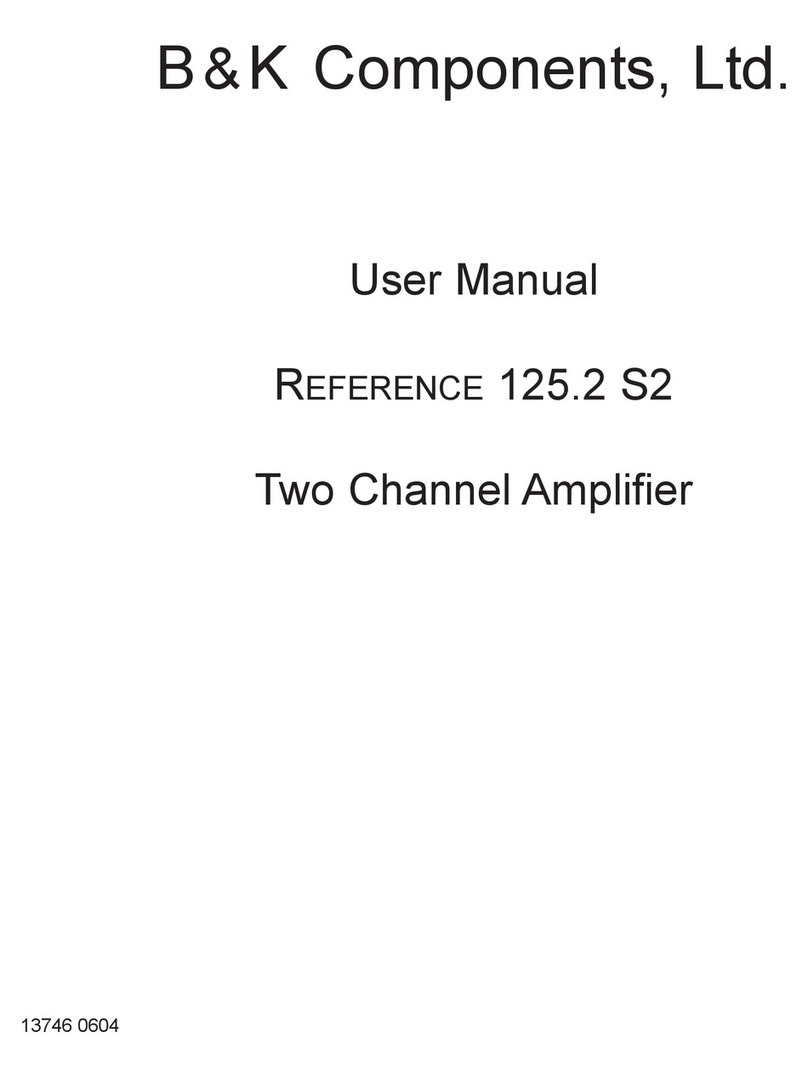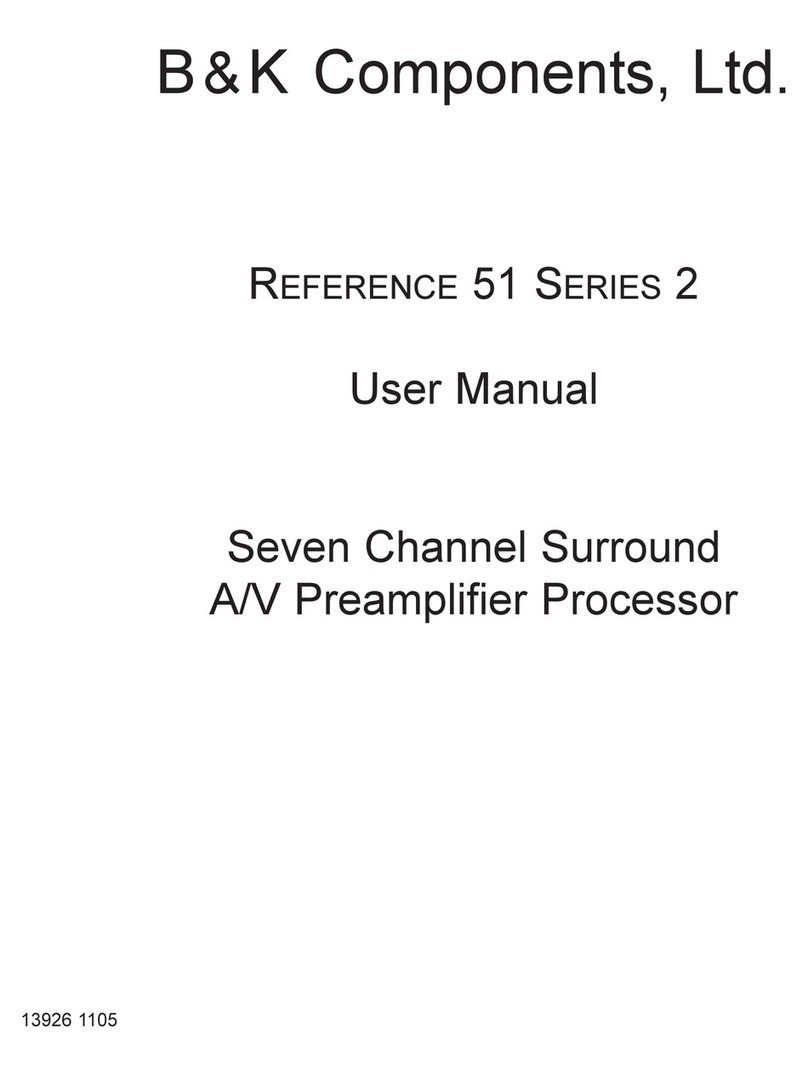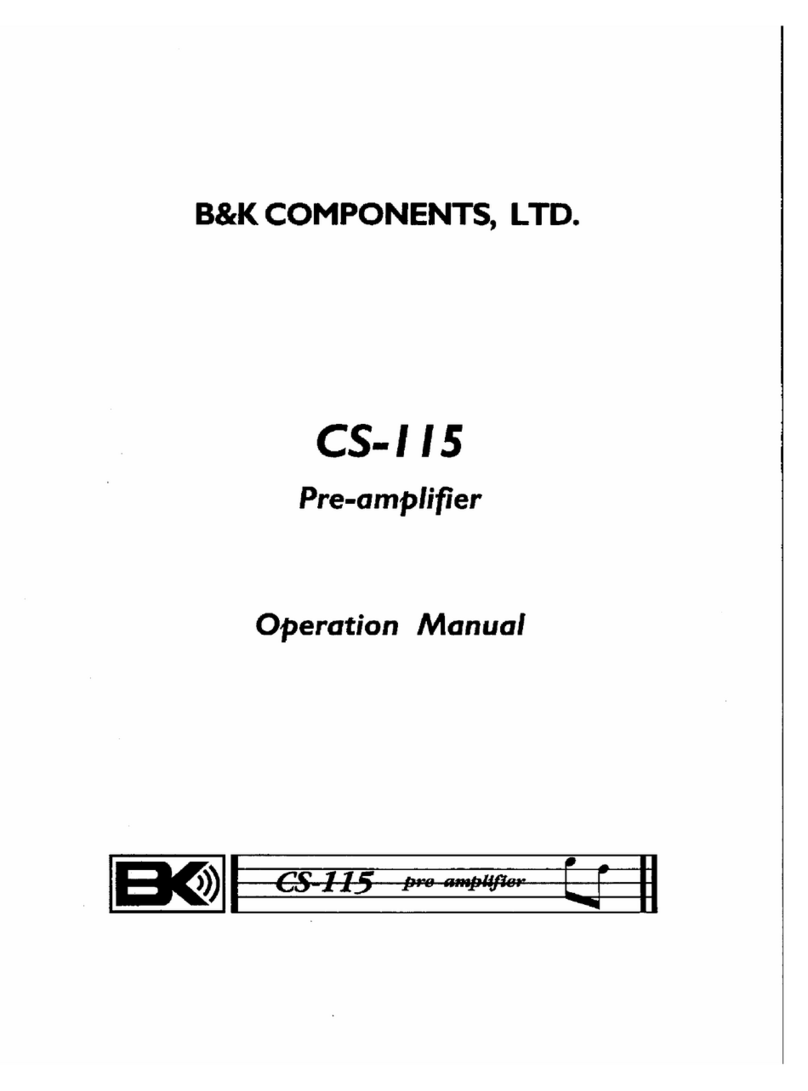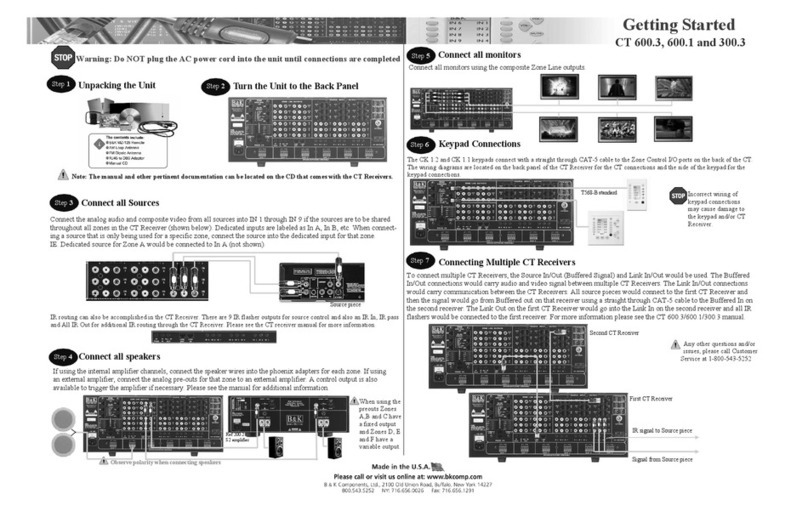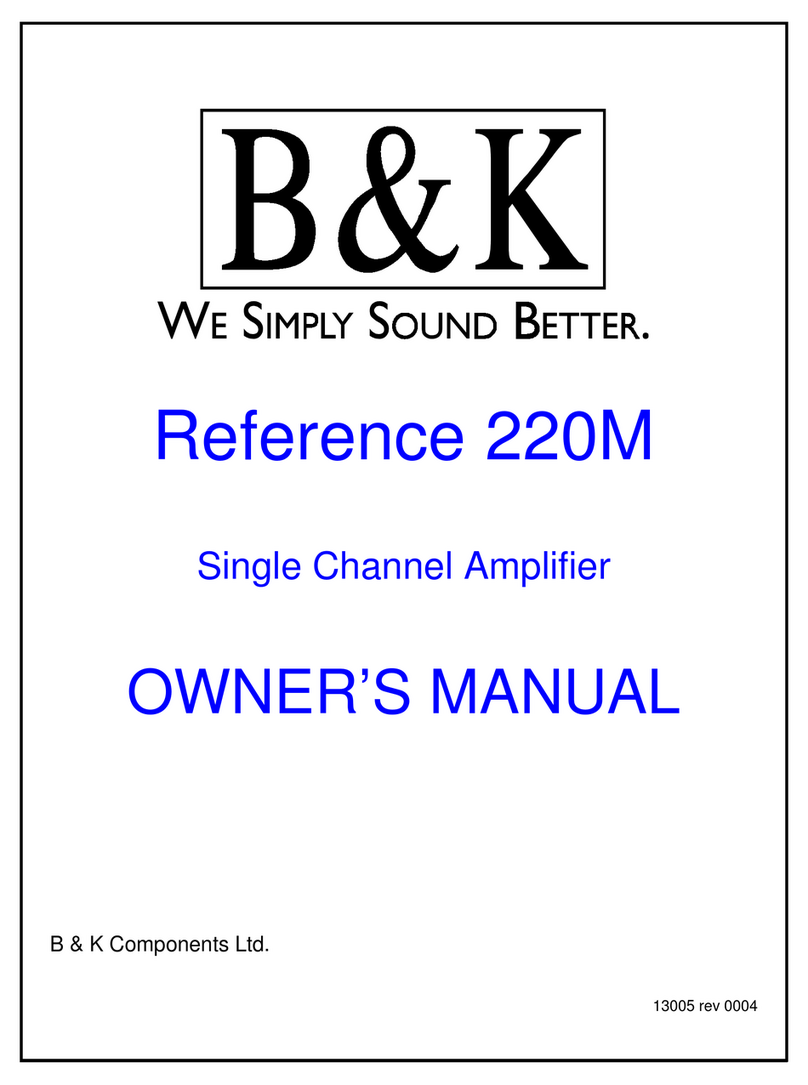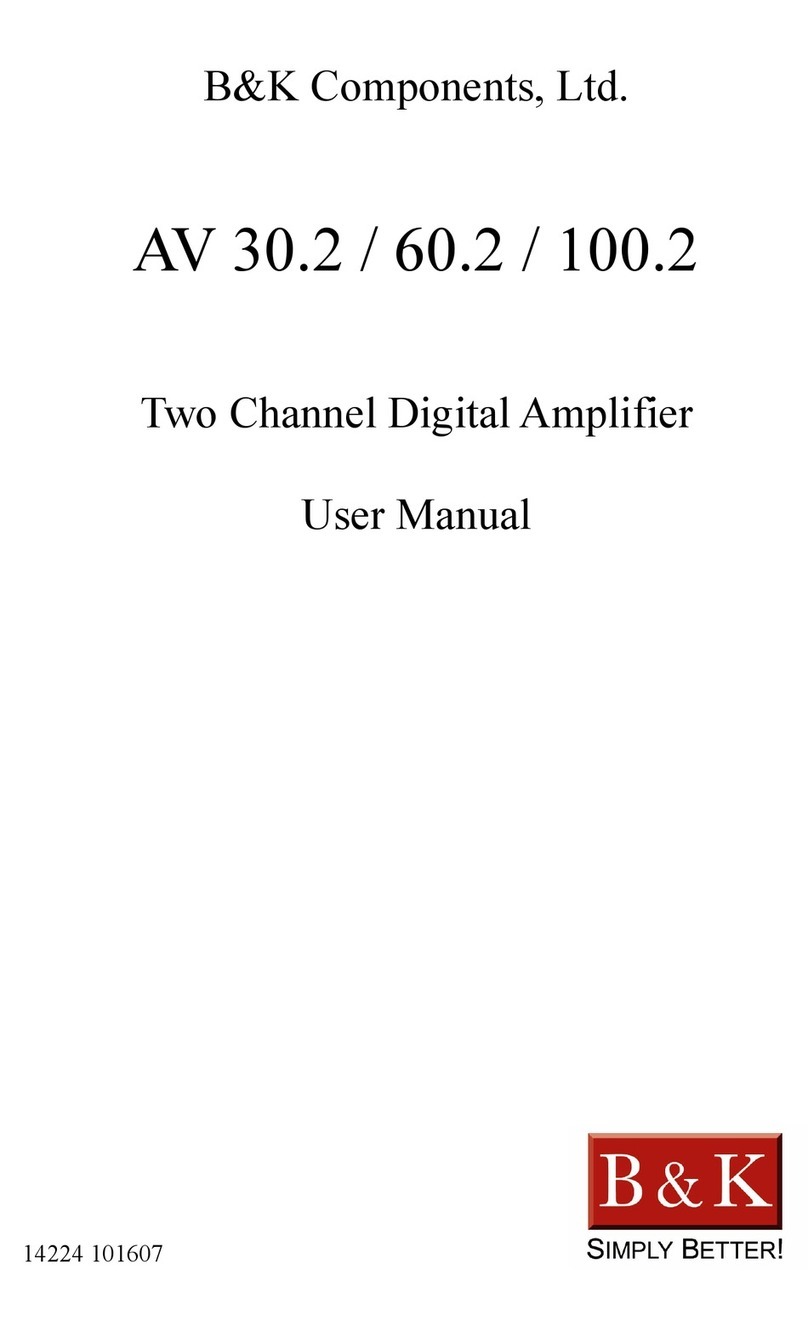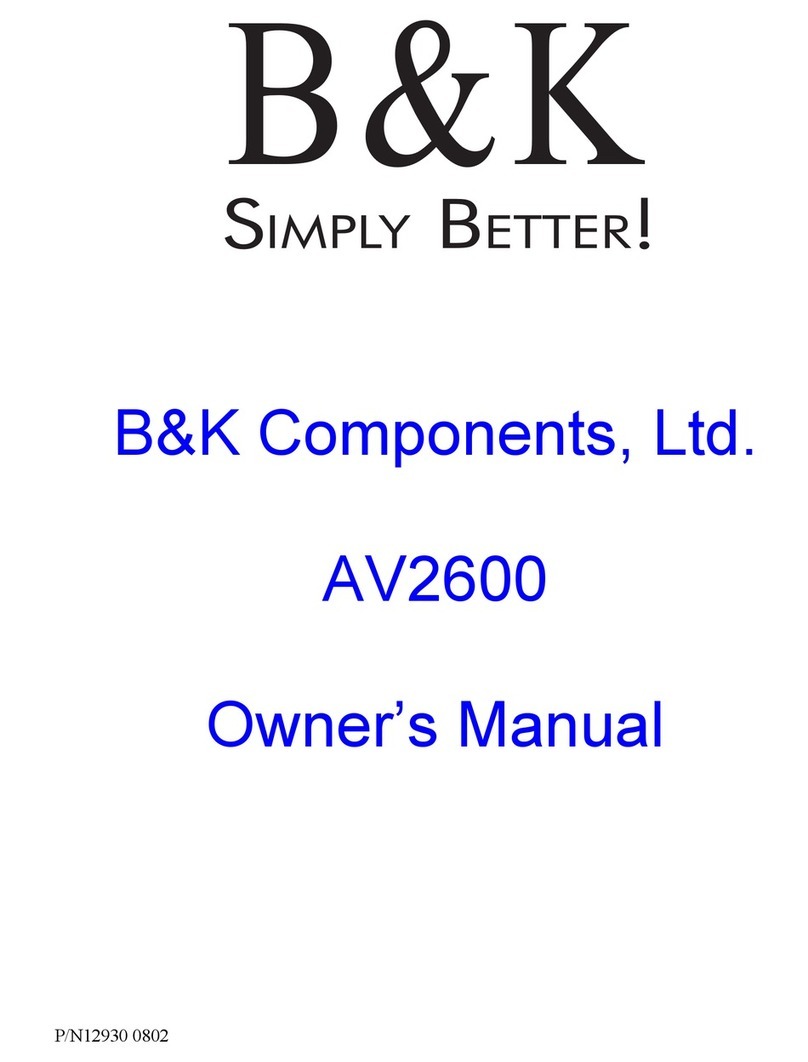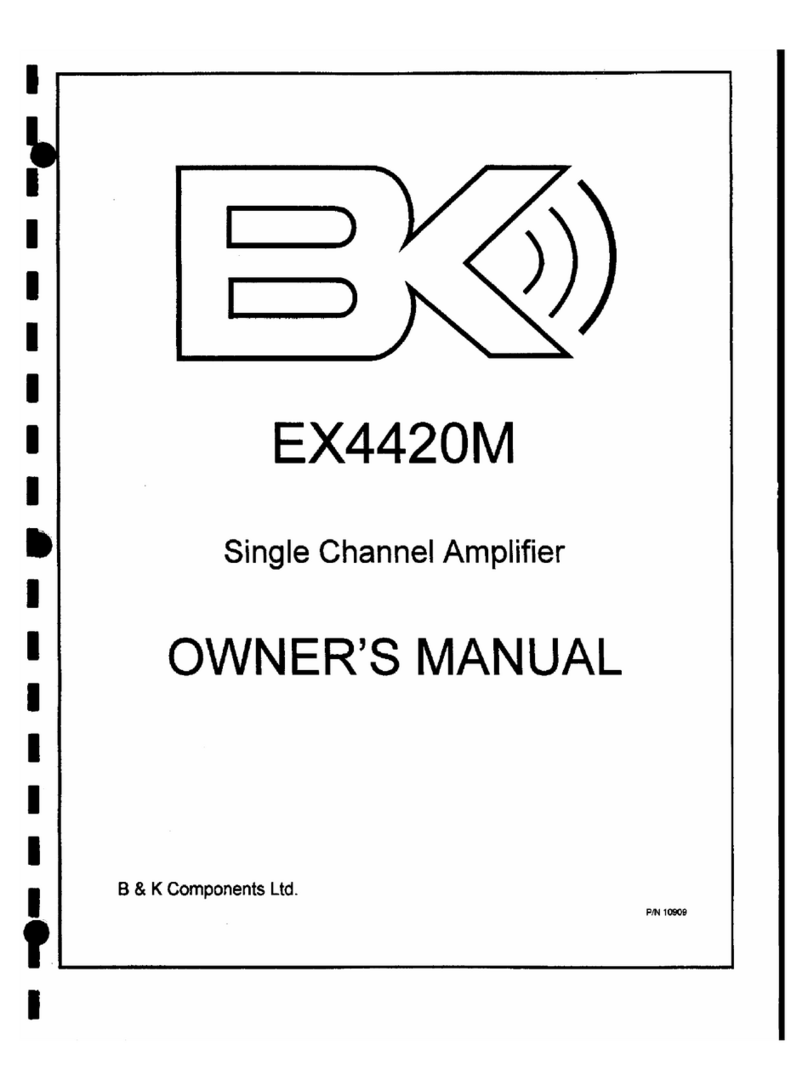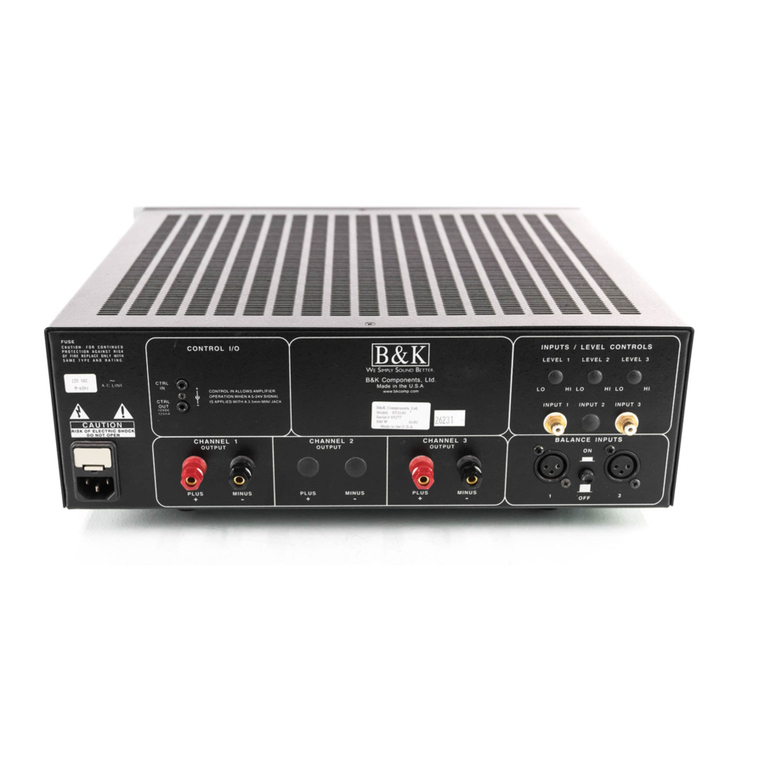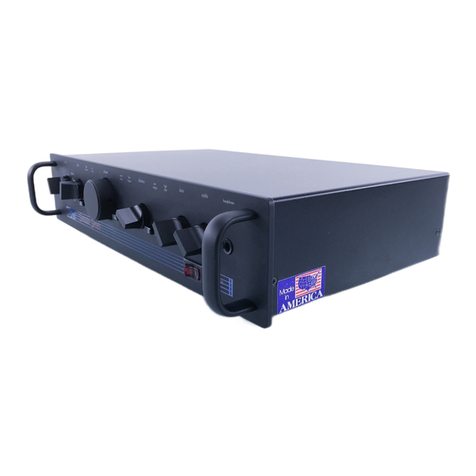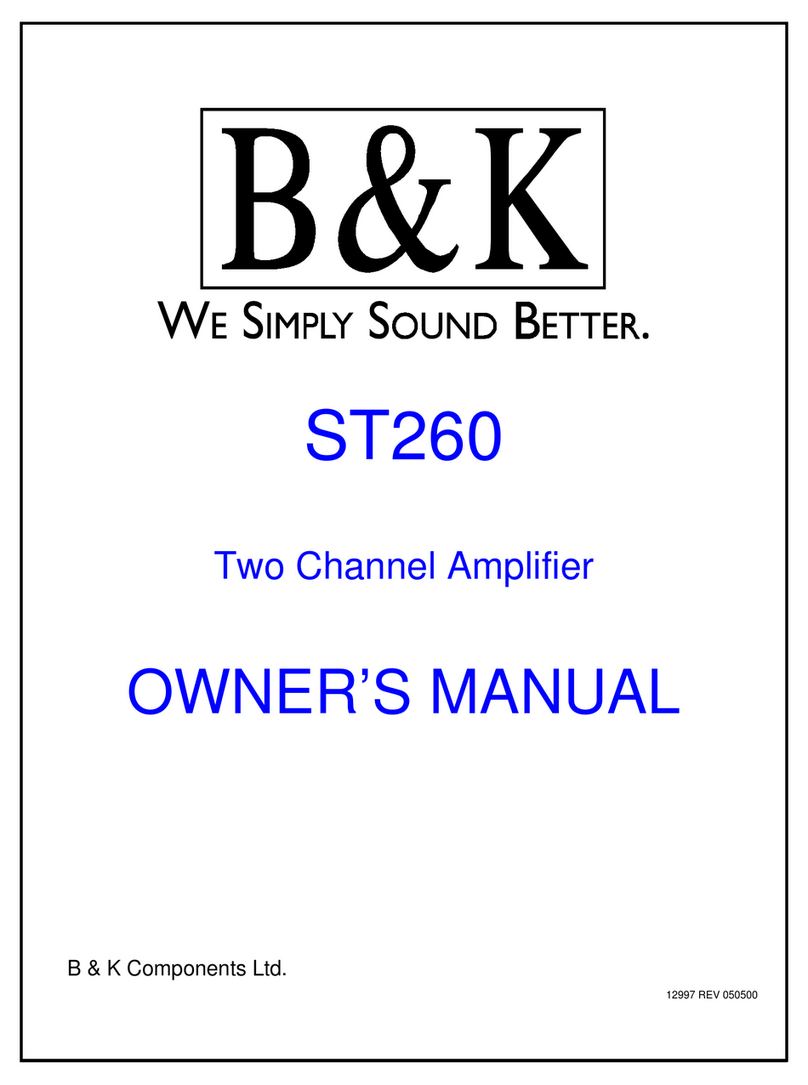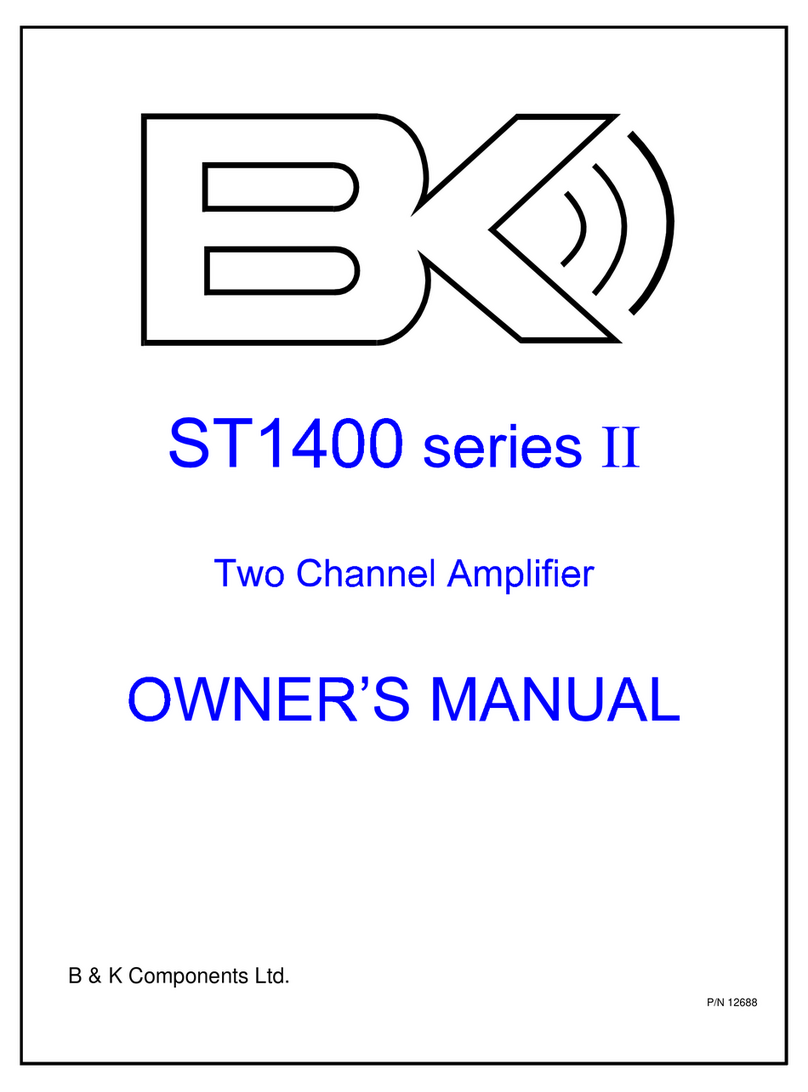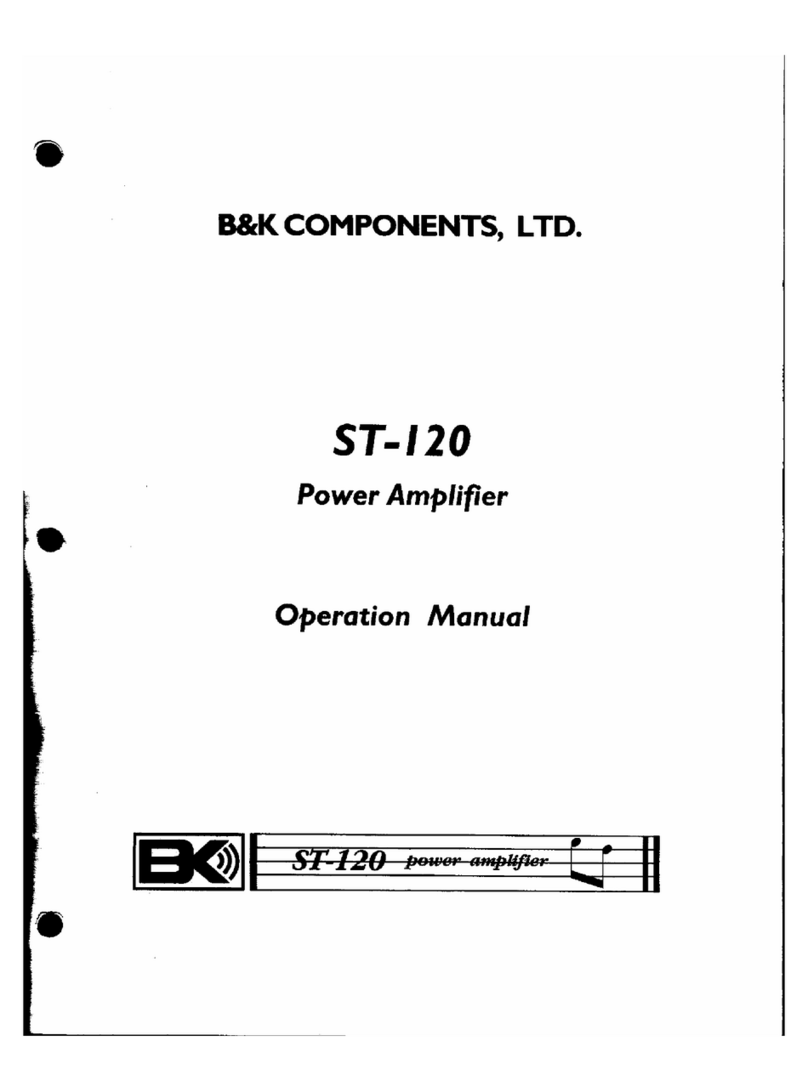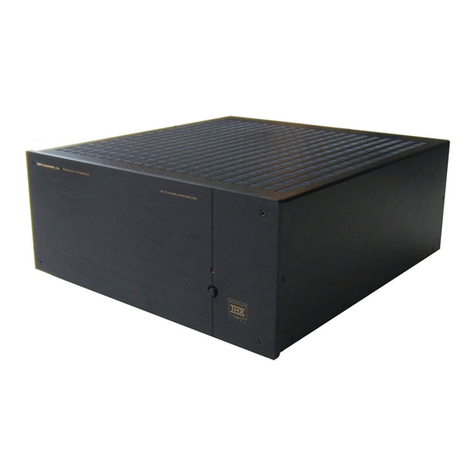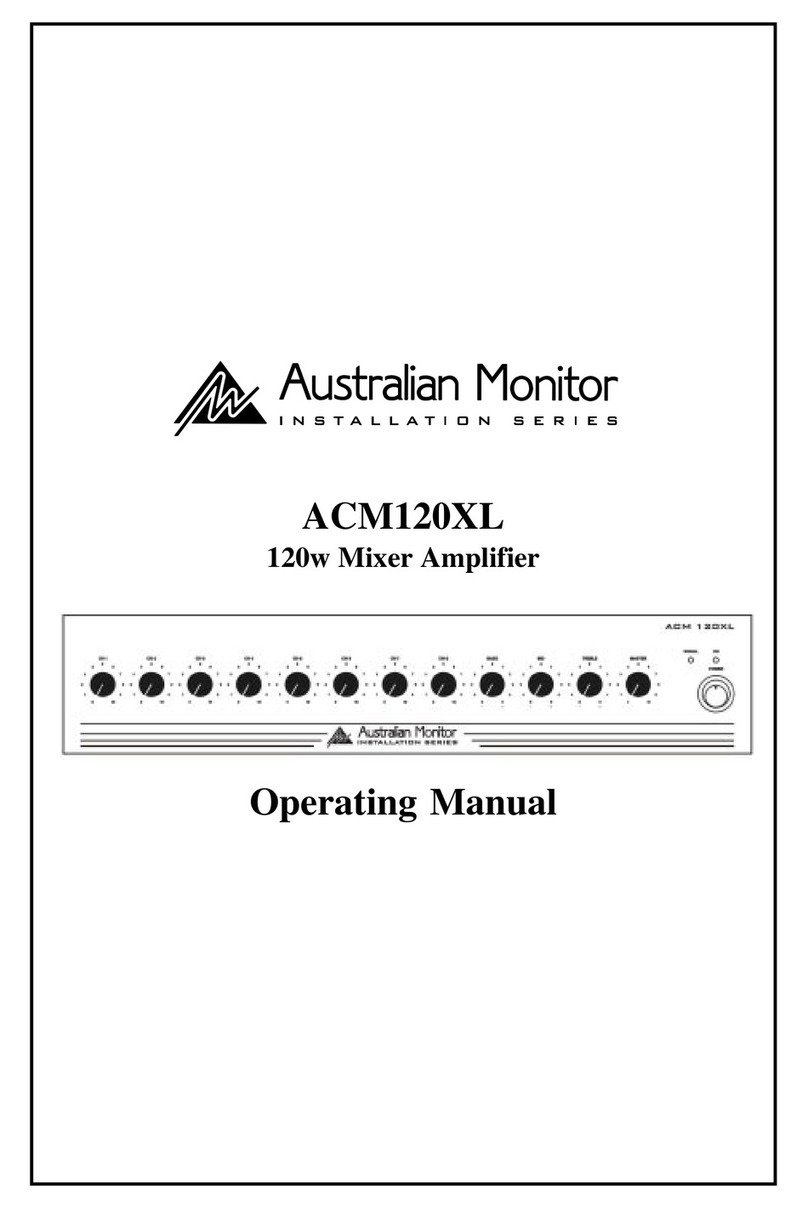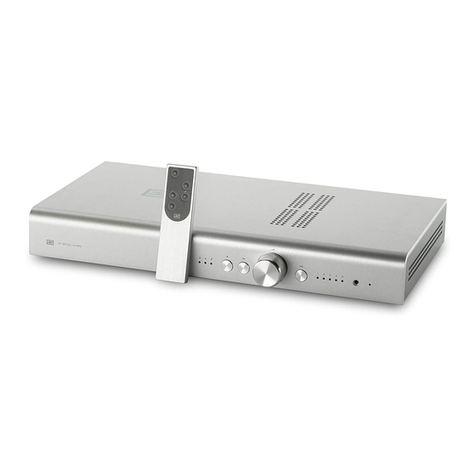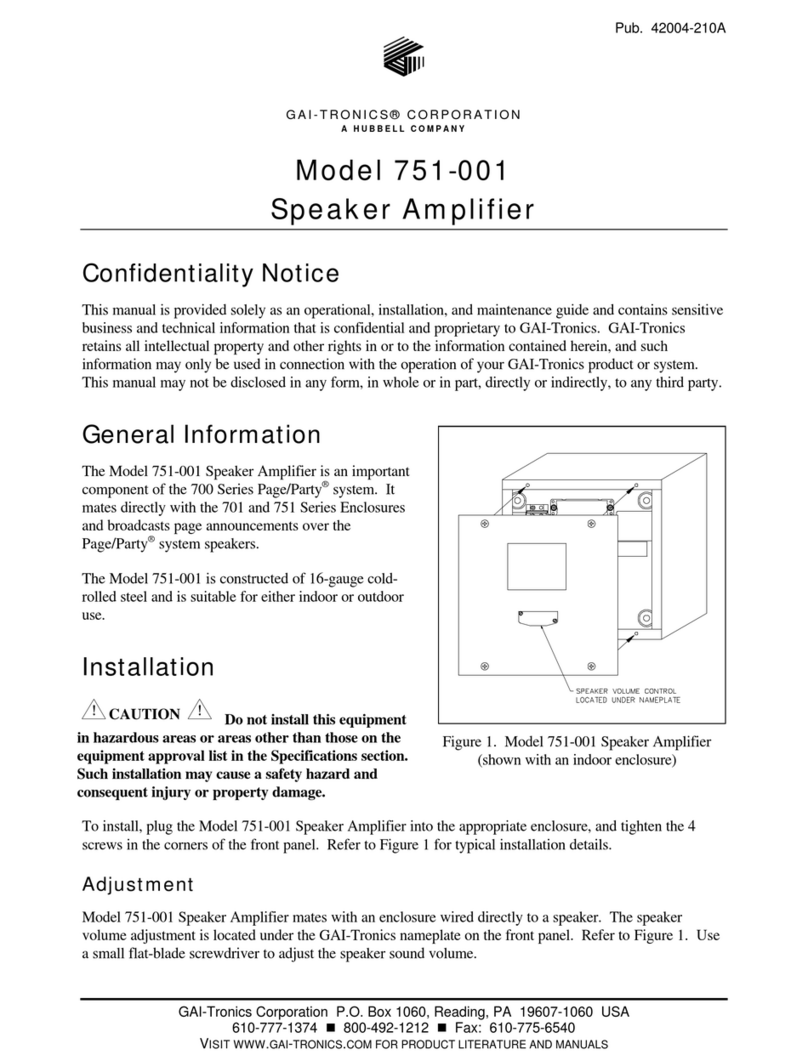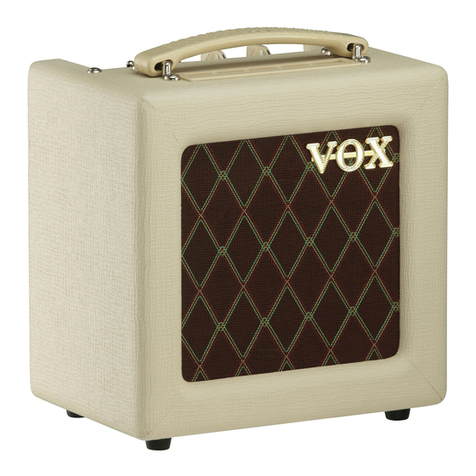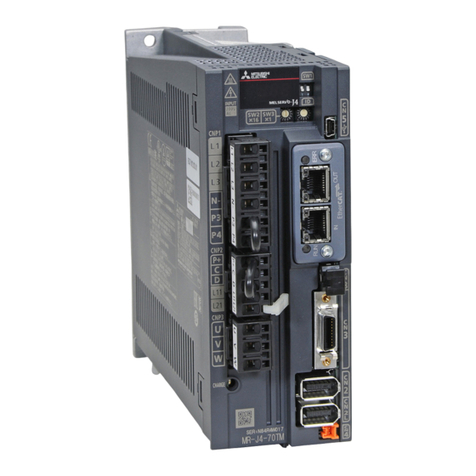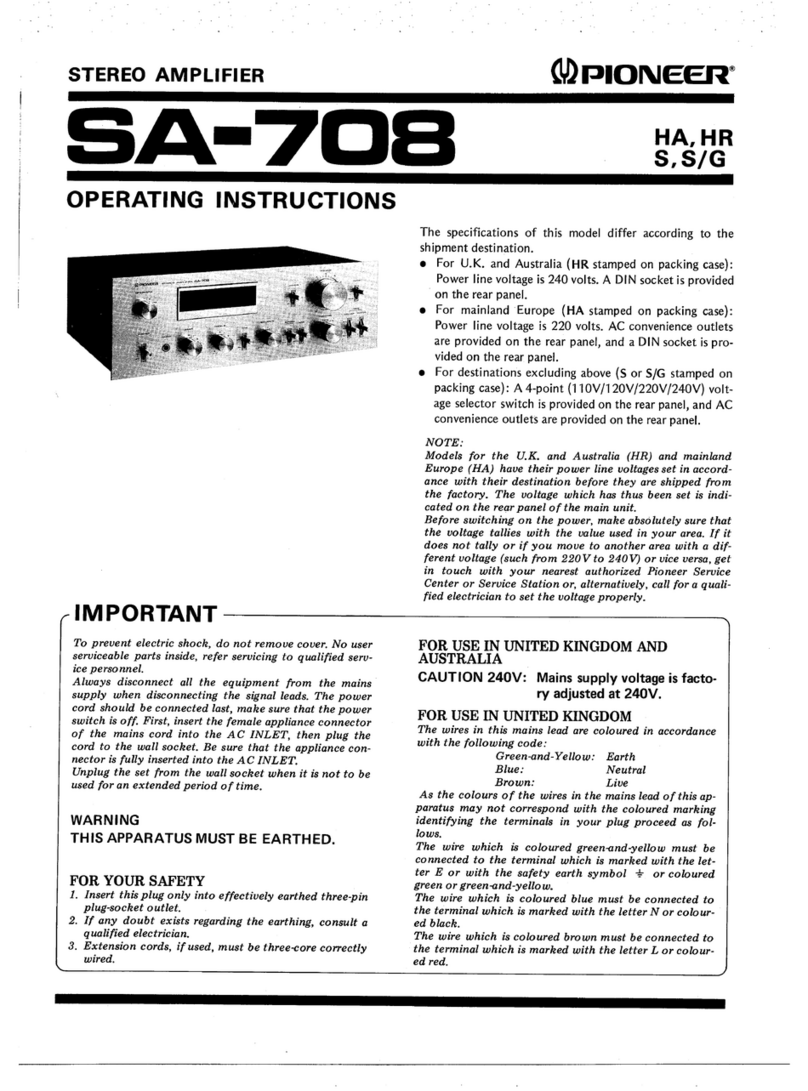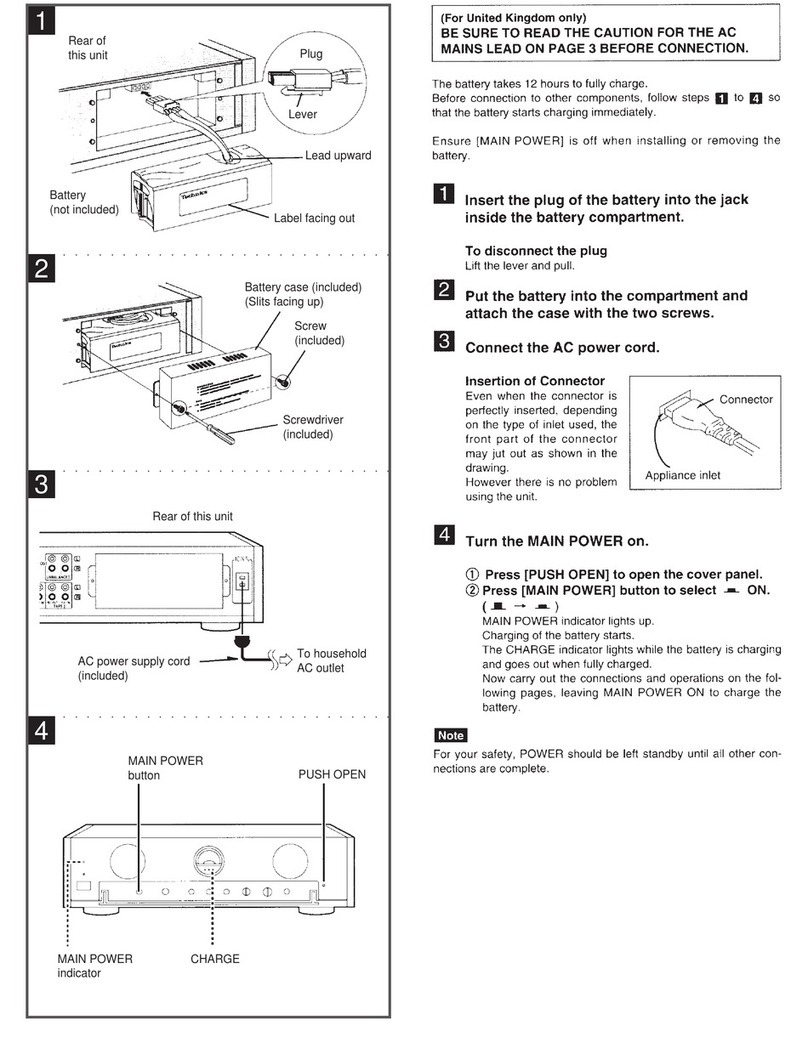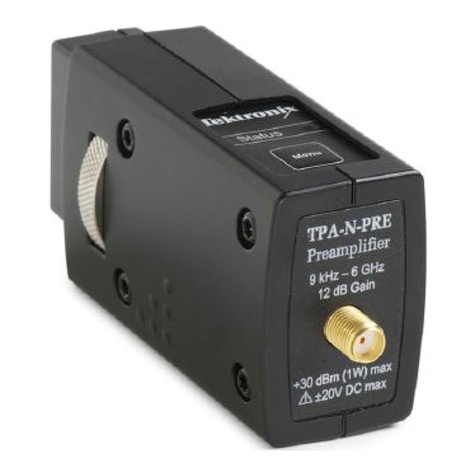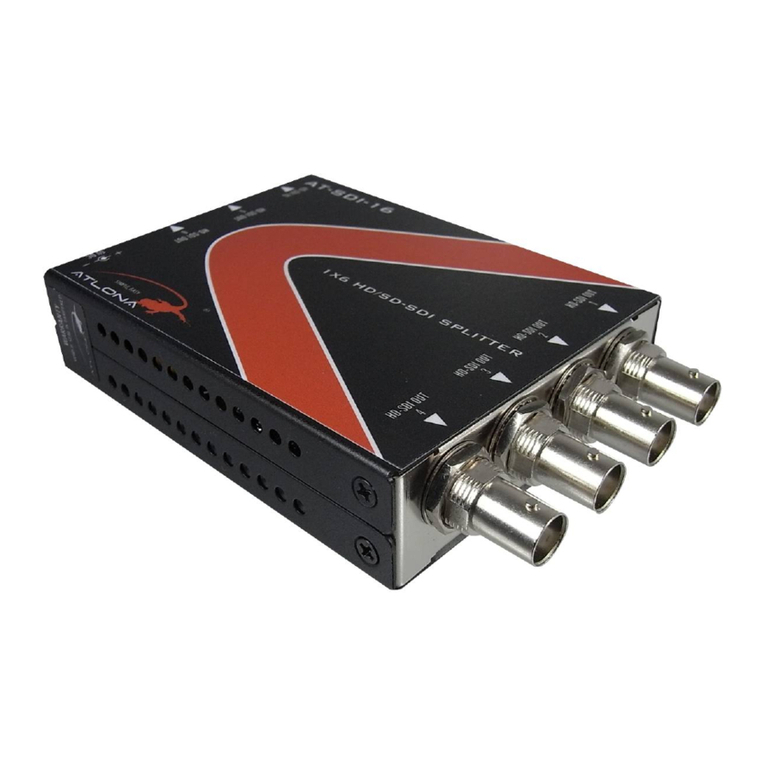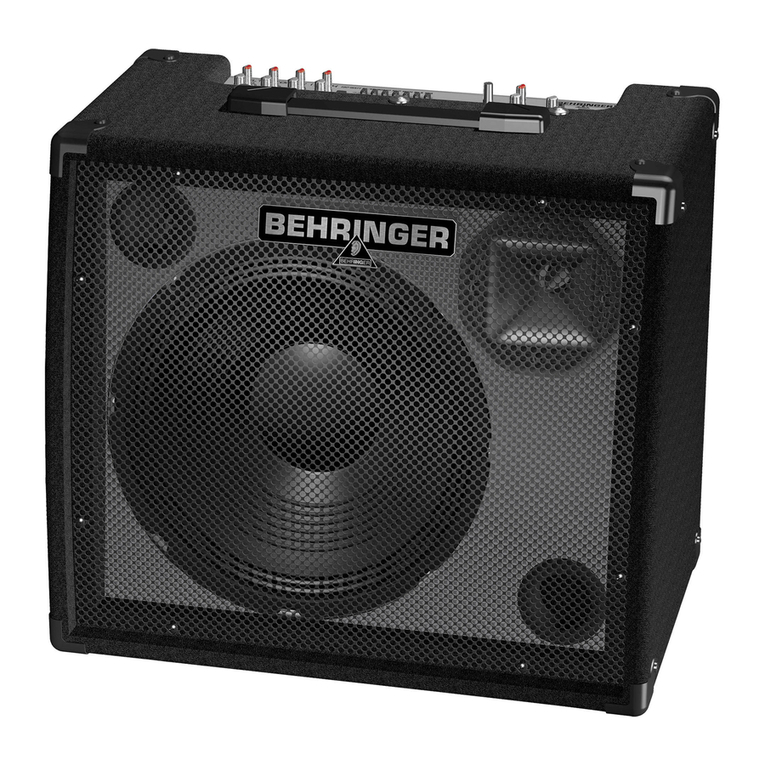B&K Reference 220M User manual

B & K Components Ltd.
P/N 12693

B&K Components, Ltd., 2100 Old Union Road, Buffalo, New York 14227

Page 1
Safety Precautions Page 2
Purpose and function Page 3
Design and construction Page 3
Features Page 3
Rear panel view Page 4
Rear panel description Page 4 - 5
Control muting Page 5 - 6
Level controls Page 6
Outputs Page 7
Inputs Page 8
System installation Page 9
Making the connection Page 9 - 10
Troubleshooting Page 11
Care and cleaning Page 11
Specifications Page 12
Warranty page 13
Manual and Power cord

Page 2
WARNING: TO PREVENT FIRE OR SHOCK HAZARD, DO NOT EXPOSE THIS UNIT
TO RAIN OR MOISTURE.
The lightning flash with arrowhead, within an equilateral triangle, is intended to alert the
user of the presence of uninsulated “dangerous voltage” within the product’s enclosure
that may be sufficient magnitude to constitute a risk of electric shock to you.
The exclamation point within an equilateral triangle is intended to alert the user of the
presence of important operating and maintenance (servicing) instructions in the
literature accompanying the unit.
Observance of polarity is essential. Double-check connections before turning
the amplifier on. The amplifier can be damaged if polarities are incorrect.
Damage can occur to your speakers if the power rating* of each individual driver
is exceeded by the amplifier. Ensure that all the drivers in your speaker system
are capable of handling not only the power being delivered by the amplifier, but
the energy that is likely to be generated during strong passages.
Turn amplifier ‘off’ when plugging in or unplugging input and speaker cables!!!
The Reference 4420M is equipped with raised feet so that continuous ventilation
can be maintained. They help to maintain acoustic feedback into the amplifier at
a minimum. They also provide a measure of protection against scratching any
surface the unit might be resting on.
Do not stack anything on top of the amplifier (preamplifier, processor,
source...etc.).
Leave at least 2-3 inches clearance from the top of the amplifier to the next shelf,
component, etc., to ensure proper ventilation.
* If you are at all unsure of what the speaker ‘ratings’ are, contact your dealer.

Page 3
The Reference 4420M is a compact, very efficient, single channel power amplifier. It is
designed to be used in all types of audio or audio/video systems.
The Reference 4420M utilizes high quality electronic circuitry to achieve an environment
wherein a detailed, transparent, and highly musical sound can be realized. The high
quality parts complement include state-of-the-art solid state devices, 1% metal film
resistors, computer grade electrolytic power supply capacitors, and a high capacity
toroidal transformer.
The Reference 4420M operates class A predriver and AB high current MOSFET power
output stages. It is capable of reproducing the most demanding audio signals at rated
power levels.
- Efficient high current transformer for improved dynamics.
- More accurate and three dimensional reproduction of source
material.
- Improves low level detail for smoother, more musical sound.
- For efficient and linear power delivery.
- Provides short term protection from accidental shorting of output
devices and protection from thermal overload.
- Improve connections for better sound and minimized signal
loss and degradation.
- Low noise resistors for better sound and a greater degree
of repeatability.
- Ability to reproduce demanding recordings.
- Large capacity computer grade electrolytic capacitors
for extended low frequency control and improved dynamics.

Page 4
1. AC fuse holder 5. RCA input (unbalanced)
2. AC Input receptacle 6. Level controls**
3. Speaker outputs 7. Amplifier control muting input/output
4. Balanced Input
1. AC fuse holder - Holds the AC Line fuse. This fuse is an 12 Amp / 250 Volt
Slow Blow fuse. Replace with same type and value fuse
only.
2. AC Input receptacle - For attaching the supplied AC power cord to the
amplifier.
3. Speaker outputs - For connecting the speakers to the amplifier. Explained
further on page 7.
4. Balanced inputs - For connecting Balanced signal patch cables (XLR).
Explained further on page 8.

Page 5
5. RCA inputs- For connecting signal patch cables (interconnects) from the
preamplifier to the amplifier to pass signal.
6. Level controls - Option available for the Reference 4420M amplifier. For
adjusting the input level to the amplifier. Explained further
on page 6.
7. Amplifier control muting input/output -
To provide remote switching of mute on/off of the amplifier.
Explained further below.
A control is provided on each Reference 4420M amplifier to allow remote switching of
mute on/off. The preamplifier’s control output, such as is provided with B&K series
preamplifiers, can be utilized to provide a control signal to the Reference 4420M. If
more than one amplifier is being controlled, the control signal can be extended to
include each successive unit by simply running an RCA type audio cable from the
CTRL OUT connector of the first amplifier to the CTRL IN connector of the next unit
(commonly referred to as ‘daisy chaining’). An example of how to connect two
amplifiers is illustrated in figure B.
If a source other than a B&K series preamplifier is used to control multiple amplifiers,
only the control output voltage from the source is critical. It must be within the range, as
indicated on the rear panel, 5-24 volts DC is required. The amplifier will provide each
successive amplifier with a control voltage of 12 volts DC for reliable operation. The
amplifiers control output may be used as a source of 12 VDC @ 125 mA for other user
applications as well.

Page 6
If the control function is desired, each unit in the system must remain connected at all
times and the control must be enabled. To enable the control function, the CTRL
ENABLE button must be out for each controllable amplifier in the system. For more
information on the amplifiers output status under various control conditions, refer to the
table below.
@ CTRL IN Button position Output status @ CTRL OUT
Signal OUT Sound Signal
Signal IN Sound Signal
No Signal OUT Mute No Signal
No Signal IN Sound Signal
The level controls are an option that can be added to the amplifier. If your amplifier has
this option, the balanced inputs are not present.
There is one level control on the back of the amplifier.
When using the level controls, first start with them turned all the way up (clockwise).
Then adjust them according to your system requirements to match the sound level
coming from each speaker.

Page 7
Five way binding posts are provided. One pair for each channel. They are designed to
accept a banana-type plug or spade lug connector (shown below) and are color coded
for easy identification. The red (+) post should always be connected to the speakers (+)
jack. The black (-) post should always be connected to the speakers (-) jack.
Spade connector Banana jack
Here is a typical amplifier setup:
The Reference 4420M amplifier has two sets of binding posts on it. They are paralleled
inside the amplifier.
The amplifier comes standard with a right and left speaker output. The left output is
used for normal operation, but you can use the right output to connect to another left
channel speaker.

Page 8
Unbalanced - RCA type connectors accept line input from the preamplifier’s
unbalanced output connectors. There are two input connectors, that
may be used to connect the amplifier to the preamplifier.
RCA cable connector -
Operation - For unbalanced operation, ensure the balanced switch between the
balanced inputs on the rear of the amplifier is in the ‘off’ (out) position. If
the amplifier does not have balanced inputs then it is always in
unbalanced mode.
Balanced - XLR type connectors accept line input from the preamplifier’s balanced
output connectors. The Reference 4420M has balanced line inputs.
Balanced cable connector -
Operation - For balanced operation, ensure the balanced switch between the
balanced inputs on the rear of the amplifier is in the ‘on’ (in) position.
Here is a typical input setup:

Page 9
There will most likely be a number of cables involved in the installation of your home
entertainment system. Pre-planning is essential in order to maximize system efficiency.
We recommend the following as a means of helping you reach that goal:
Make a diagram of your proposed system by laying out the relative location of
each component in the system. Then lay out the proposed cable runs between
them. Number each cable and record its length on the diagram for future
reference.
Cable runs are critical in that they must be kept away from sources of power
radiation (amplifiers, power cords, heaters, etc...). For the sake of safety, they
should also be kept out of traffic areas.
The process of optimizing the system will include the type of cable, the length of
the run, and the obstructions it must deal with along its run. Your dealer can
advise you on the products available and their relative merits. If building custom
length audio cables is not your strength, your dealer should be able to help you
with that as well.
When possible, use a separate AC power line for the amplifier, one that is not
shared by any other component in the system of any other house hold
component.
Before doing anything, ensure that the power switch on the amplifier’s front panel
is in the ‘off’ position. Again, it is recommended that you locate a separate AC
power outlet for the amplifier, one that is shared by any other audio
component in the system or any other house hold component. This will eliminate
the possibility of the amplifier ‘modulating’ the power being supplied to the
component and compromising the signal originating from that component.
Locate the AC power cord provided with the amplifier and plug it into the power
input receptacle in the rear panel.
Connect the audio cables from your preamplifier’s output to the corresponding
input connector on the amplifier.

Page 10
Connect the wires from your speakers to the appropriate output on the amplifier.
It is absolutely essential that you observe correct polarity in these connections.
Double check all connections.
Plug the amplifier’s power cord into the AC power source. Turn the amplifier’s
power switch ‘on’. The panel light should be illuminated. Leave the preamplifier
turned off. Before proceeding to the next step turn the amplifier off and wait 30
seconds for the amplifier to discharge. Both the preamplifier and amplifier
should be off.
Connect a playback unit (CD, VLD, Tuner, etc...) to the preamplifier. Turn the
volume on the preamplifier to minimum. Turn on the preamplifier, then the
amplifier (in that order). Set source on the preamplifier to the playback unit
you’ve just connected. Turn volume up slowly and music should be heard from
all channels. If this is not the case, double check your installation.
Should you encounter any problems that cannot be traced to the source or the
material being played, consult the “TROUBLESHOOTING” section on page 11.

Page 11
PROBLEM POSSIBLE CAUSE POSSIBLE SOLUTION
No sound 1. Power cord not plugged in. 1. Reconnect power cord.
(‘on’ LED not illuminated) 2. Power off at AC source. 2. Check AC switch or fuse.
3. AC power inlet fuse blown 3. Check for shorts or
or faulty. overloading.
4. Control switch in the wrong 4. Place control switch in
position. proper position. (Page 5)
No sound on some or all 1. Speaker leads loose or 1. Tighten, repair, or
selected channels (‘on’ faulty. replace cable.
LED illuminated) 2. Line stage to amp. cables 2. Tighten, repair or replace
loose. or faulty. cable.
3. Source to line stage cables 3. Tighten, repair or replace
loose or faulty. cable.
4. Line stage or source not 4. Check all switch settings.
correctly selected.
Sound lacks direction, 1. Speakers connected out of 1. Check connections
bass weak phase. making sure that cables
are connected (+) to (+)
and (-) to (-).
Loud hum or buzz on one 1. Poor ground connection in 1. Check all connectors and
or more channels interconnect cables. repair as necessary.
Low output from amplifier 1. Balanced switch in 1. Put balanced switch in
balanced mode when correct position.
using unbalanced inputs.
Channel sounds distorted 1. Blown rail fuse. 1. Replace blown rail fuse
and low in output inside amplifier.
** Note
: If unit continues to blow power inlet fuses,
have it serviced.
Under normal use, the amplifier will not require any special care. Over time you may
wish to clean the exterior of the unit by wiping it with a damp cloth to remove any dirt or
dust that accumulates on it. Do not let any liquid enter the amplifier thru the vents in
the top cover. You may clean the connectors on the rear panel with isopropyl alcohol
annually.

Page 12
Power rating: 8 ohms 250 watts @ 1 kHz
4 ohms 400 watts @ 1 kHz
Frequency response 5 Hz - 45 kHz
Input sensitivity 1.4 Volts
THD (S+N) 0.09 % @ 1 kHz
Input impedance 33.2 k ohms
Damping factor 750
Current (peak to peak) 150 Amps
Slew rate 14 V / )sec
Dynamic headroom 1.4 dB
S/N (A-weighted) 95 dB
Voltage gain 28
Line voltage 120/220/240 VAC switchable
Dimensions (O.A.) 17"(w) X 15.5"(d) X 5.75"(h)
Weight 42 lbs
Power consumption 350 watts max
4 Amps max current draw
85 watts @ no input
Replacement fuses Line -12 Amp/250 Volt Slow Blow
Rails - 6 Amp/250 Volt Slow Blow

Page 13
B&K Components Ltd., referred to herein as B&K, warrants your B&K equipment against all defects in
material and workmanship for a period of five years from the date of purchase. This warranty applies
only to the original purchaser and only to equipment in normal residential use and service. Defective
equipment must be returned to B&K, prepaid, accompanied by sufficient payment to cover the cost of
return shipping and handling, and will be repaired or replaced at the discretion of B&K whose decision
as to the method of reparation will be final.
This warranty shall not apply to any equipment which is found to have been improperly installed,
incorrectly fused, misused, abused, or subjected to harmful elements, used in any way not in
accordance with instructions supplied with the unit, or to have been modified, repaired or altered in any
way without the expressed, written consent of B&K. This warranty does not apply to the cabinet, the
remote controller, or appearance items such as the faceplate, control buttons, or display lenses, nor
does it cover any expenses incurred in shipping the unit to and from the manufacturer’s service depot.
No warranty, implied or otherwise created by State law shall extend beyond the terms of this warranty
and B&K shall not be liable for any incidental or consequential damage arising out of a defect in material
or workmanship of the unit during the terms of this warranty or thereafter. Some States do not allow the
exclusion or limitation of incidental or consequential damages and the foregoing exclusions may not
apply to you.
This warranty gives you specific legal rights. Your may also have other rights which vary from State to
State.
No agent, representative, dealer or employee of B&K has the authority to increase or alter the
obligations or terms of this warranty.
B&K Components Ltd.
No equipment may be returned to B&K Components Ltd. Without a RETURN AUTHORIZATION.
Should you find it necessary to return equipment to B&K, for any reason, a RETURN AUTHORIZATION
(RA) number must be issued by B&K in respect of the equipment being returned. You may request an
RA number by calling B&K at the numbers below. We ask that you provide the following information at
that time.
1. Your name, address, and phone number.
2. The model and serial number of the equipment being returned.
3. A description of the problem being experienced.
Your call will be referred to a Technical Service Representative who will work with you to resolve the
problem. If it is determined that the unit must be returned for repair, an RA number will be issued.
B&K Components Ltd. 2100 Old Union Road, Buffalo New York 14227
1-800-543-5252 or 1-716-656-0023

B&K Components, Ltd.
2100 Old Union Road
Buffalo, New York 14227
716-656-0023
www.bkcomp.com
Other manuals for Reference 220M
1
Other B&K Amplifier manuals
